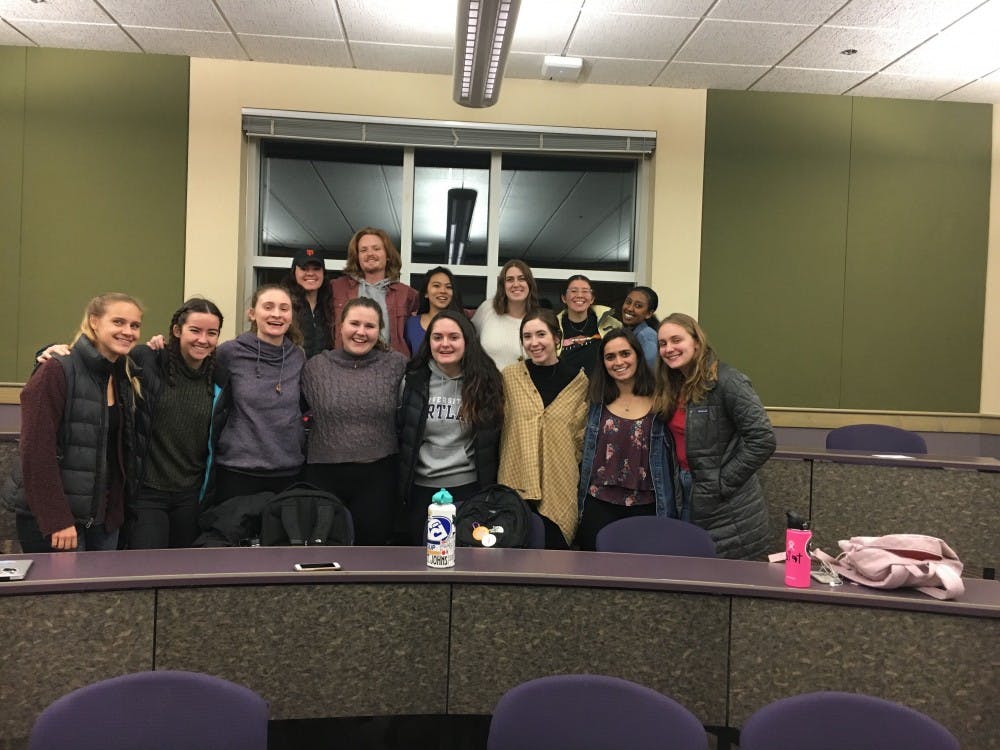Remember the thrill of elementary school field trips, the excitement of getting to leave the classroom and explore the outside world? Imagine a college course where the idea of leaving the classroom and entering the outside world was the focus, and you’ll begin to have a sense of a new class that was offered this fall semester, called Social Determinants of Health.
Social Determinants of Health provided students with a unique interdisciplinary approach to the different factors that influence the wellbeing of communities. The course’s interdisciplinary perspective means that students study the subject from several different ways of looking at the experience faced by low-income households. By hosting about half of the class meetings off campus in the New Columbia neighborhood, the course gives students a hands-on experience that places them directly into the lives of people who have faced economic and health challenges.
The class was created by three professors: Associate Professor of nursing Barbara Braband, Associate Professor of political science Anne Santiago and Assistant Professor of education Kimberly Ilosvay. After attending a conference in Seattle in the summer of 2017 that emphasized the value of solving community problems, Braband challenged the other two professors to do something with the knowledge they had received. The result was Social Determinants of Health class.
The New Columbia neighborhood located in North Portland was chosen as the community of focus because of Braband’s past volunteer experience there and its proximity to campus. New Columbia is a mixed-income community of about 4,000 people that is managed by Home Forward, a public government agency that provides assistance to underprivileged communities.
Several different organizations service the New Columbia community, providing such things as after-school programs and community gardens. A central component of Social Determinants of Health is linking students to one of these organizations and getting them involved in their service work. Students this semester have been working with Village Gardens, Rosa Parks Elementary School, Rosemary Anderson High School and the Charles Jordan Community Center.
Junior Lauren Urbina, one of 14 students in the class, has been helping TA at Rosemary Anderson High School. She said the course has made her very aware of the messiness of social service work and reminded her of the importance of giving back to your community.
“I think it’s easy for us to stay insulated on the Bluff and kind of not step out into the community,” Urbina said. “(It’s) not necessarily anybody’s fault, per se, but it’s great that the school is kind of addressing that through having some courses that we get to go off campus for.”
Santiago said that the course has allowed students to examine the structures of society that lead to injustices and hopes that long term connections to New Columbia might come as a result of the class. By immersing themselves in the New Columbia community, students receive a different learning experience than in the classroom.
By moving past theoretical principles and getting to actually talk to and hear from individuals facing struggles, the class humanizes the issues students are studying. It puts faces and names to abstract concepts.
“The people that I’ve come to know in New Columbia have shown me more about just the nature of humanity than any book could tell me,” Braband said. She said that their goal as professors for the class is for every student to develop at least one relationship before they leave so that they really know the residents.
By bringing in speakers from the community to talk to the class, Braband hopes that students are learning to understand the impact of health disparities, political actions and the impact of education on community health. One one occasion, students in the class got to hear from a resident who was a Congolese immigrant and had faced the challenges of poverty and fitting in to a foreign society.
The course is cross-listed in the both the school of nursing and education, meaning that students who are enrolled are signed up for it for either of those schools. Braband said that she thinks the course has an appeal for anyone interested in social justice, not just nursing, education and political science majors.
While only 14 students are currently in the class, Braband said that they could handle upwards of 25 to 30. Despite her optimism, though, its future remains uncertain.
"It won’t be offered next semester, and there’s a question of whether it will be offered again,” Braband said.
But the professors are passionate about its impact and hope to see it offered again. Braband said that she thinks the course has the potential to teach things to students in ways that a standard classroom simply couldn’t.
“Our goal is to be a presence there, for them to know we care,” Braband said. “The people that I’ve come to know in New Columbia have shown me more about just the nature of humanity than any book could tell me.”
Wes Cruse is a reporter for The Beacon. He can be reached at cruse20@up.edu.








